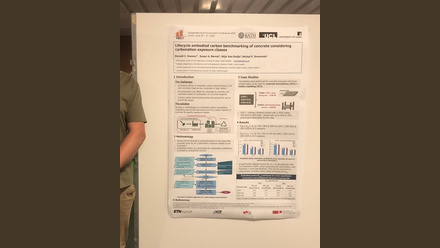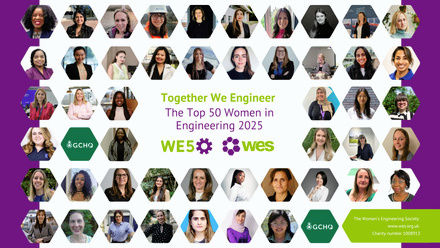Cultivating a change
Andrea Gaini speaks to three diversity and inclusion advocates about how the STEM community can do better to welcome all under-represented minorities and tackle experiences of Imposter Syndrome relating to lack of diversity in the workplace.

Panelists:
Natalie Cheung, Civil Engineer and TED-Ed Speaker (NC)
Karel Green, Astrophysics PhD Student and Founder of POC2 (KG)
Shaun Woodman, Materials Scientist (SW)
What has been your experience of Imposter Syndrome relating to diversity since you started studying and working in STEM?
NC: Early in my career, I joined women’s networks and events from different organisations and found Imposter Syndrome was a hot topic. While there were many experiences discussed that I could find relatable, the expectation that almost all women experience Imposter Syndrome was overwhelming. I would recommend the recent Harvard Business Review article Stop Telling Women They Have Imposter Syndrome.
KG: I would say it's been pretty strong throughout my time in STEM. The first thing that always comes to mind is how I have consistently been the only black woman in all of my work, and this has been consistently true even from my GCSEs (when everyone else opted out of doing triple science except for me). Even during my undergraduate and Master’s, there were significant numbers of white women and South Asian students, but never any other black people.
SW: How many times have I looked around the room and asked myself, ‘Why does no one here look like me? Am I good enough to be here? Am I just filling a quota?’ The answer is too many times. I have often sat in board rooms feeling isolated and under-represented. These internal battles influence your output significantly because your confidence is shattered, and your success is never truly celebrated. I’ve even stopped myself from applying for certain roles or scholarships because I felt that I wasn’t the right candidate for the role.
How do you think the under-representation of certain communities in STEM impacts Imposter Syndrome?
NC: It’s easy to feel like you don’t belong somewhere if you are one of the ‘only’ in a working environment. This all feeds into the Imposter Syndrome someone might feel.
KG: It for sure makes it worse. Practically, it impacts the most the higher you go in the academic career ladder, making the idea of jobs like lecturing or applying for research grants almost unbearable knowing you’re going to have to assimilate into the cis-het-white* group that will no doubt have all the money and resources.
SW: Diversity must be a cornerstone for every organisation because representation allows individuals of different communities to feel that they belong and that they are valued. Isolation of individuals will often lead to feelings of anxiety when dealing with groups that are more represented in the community. Although it may be internal, it feels as if our voices are not heard, or worse, not respected. In my own experience, under-representation has been a common thread when dealing with mid-to-senior level managers. I have little or no reference point to any person or group which makes me question my own position as a leader.
What sort of behaviours or environments do you think can trigger these feelings?
NC: Although there are many ways we can boost our own confidence to overcome Imposter Syndrome, someone doesn’t just feel like an imposter – they are made to feel like imposters. The blame and onus is not on the individual with these feelings. In particular, scenarios where people feel the pressure to perform, are not recognised for their work, or feel like they do not receive the respect they should, can trigger feelings of imposter syndrome.
KG: Again, being the sole black woman in any space sets you apart. Unlike other marginalisations that are not literally surface level, skin colour is not something you can hide and reveal as and when you feel safe, so it leads to a lot of constant anxiety.
SW: As an engineer, I feel that the engineering environment can often trigger feelings of Imposter Syndrome. Intelligence and competition go hand-in-hand in the engineering environment, so it can often trigger feelings of inadequacy or self-doubt in individuals. It may be more triggering for women, people living with disabilities and members of the LGBTQ+ community as the typical demographic is very cis-male orientated. This goes back to the previous point about representation in communities and how lack thereof can impact Imposter Syndrome.
What effect can this have on an individual personally or professionally?
NC: It affects every individual differently, but some effects include overworking to chase perfectionism or prove their worth, not feeling confident to be their authentic self and feeling uncertain when contributing new ideas.
KG: The effect is Imposter Syndrome. So, you feel like you should not be in a space that adds to the anxiety in your mind. Professionally, this also compounds with bias in career progression. We know the shocking statistics on how BAME people (especially women of colour) are chronically under-hired despite having the same level or better qualifications. So, a person thinking they’re not good enough and then not being able to progress due to reasons outside of their control feeds into the idea that they can’t achieve what they want to because of who they are, when the truth is outside influences are systematically biased.
SW: Imposter Syndrome can be damaging to your personal and professional life. Even though you may continue to function at an acceptable level, your true potential may never be realised because you feel paralysed by feelings accompanied by Imposter Syndrome. In some instances, individuals may feel underservant of their positions, or worse feel like a fraud, even though they truly belong in those positions based on their merits and skills.
‘Putting people of colour into the equation’
Karel Green, Founder of POC², reveals how the group is working to improve diversity in academia.
‘It originated from the fact that myself and a couple of my POC² colleagues in undergrad found our representation…sorely lacking, both in terms of people of colour (POC) in the undergraduate physics, staff cohort at postdoc and professorship levels, and in terms of the fact that there were practically no POC individuals mentioned in our curriculum – the vast majority of scientists we learnt about were cisgender* white men.
‘In addition to this, we realised that all the scientific experiments and institutions we learnt about were based in the West. The aim of POC² is to bolster POC representation in STEM, particularly at PhD level and beyond as this is where people go from paying to attend university to being actually paid to do research’.
POC² are working towards tackling these issues. ‘We have developed three programmes…where we will work directly with universities to make changes via practical and systematic solutions,’ their website reads.
‘We’re also working towards the goal of having institutions themselves lead this work, not underprivileged Black Minority Ethnic (BME) undergraduates.’
‘We are working to fundamentally change how staff are hired for paid PhD and academic positions as well as call out and remove the numerous number of unethical practices currently featured in mainstream STEM curriculums. Finally, we highlight the lesser-known stories of BME (especially of women of colour) in STEM via our blog to encourage others to consider applying for PhDs,’ it concludes.
How can employers, networking events’ organisers and institutions create a more welcoming and inclusive environment for all communities?
NC: There isn’t one quick fix as it is an ongoing journey involving every single one of us. To start, I think it’s important to have buy-in from all levels of the organisation, not just HR and not just senior management and not just those in diversity networks. I would also expect to see recognition of individuals’ contributions and sharing praise where it is given.
KG: Talk about how they are actively working against racial bias in hiring and fighting racism in the workplace. Make sure more people of colour (POC) are on the panels at networking events. Make sure the hiring room is diverse and actually welcoming (putting a sole person of colour on a panel is a token gesture if they themselves do not acknowledge there is a systemic problem and are not inclusive in their views).
SW: Employers/institutions/organisers need to take a proactive approach to inclusion and representation. Address issues and topics as they arise (e.g. Black Lives Matters, International Transgender Day of Visibility, disability representation, etc.) to show their employees/students/members that they are represented and that their stories matter.
What can the STEM community do to enhance its reach to under-represented communities?
NC: STEM organisations connect with under-represented communities in many ways, possibly as employees, members, consumers, the local community, and more. It is important to include members of the under-represented communities in your work from planning stage and through delivery. With continued work, over time, you can create a space where honest feedback will be shared, allowing your organisation to improve and succeed.
KG: Hire more people of colour to do research, and pay them for taking part in outreach events. Have a more diverse curriculum where the achievements of scientists of colour are prominently featured and also shine a light on the racism and biases of white scientists (more information about this can be found on the media section of the POC² website). Have an Equality, Diversity and Inclusion (EDI) team which is properly diverse and gets paid for their work, and support groups specifically for people from ethnic minority backgrounds. At the end of the day, people need money to pay their bills under capitalism so no amount of one-day events or training sessions are going to help if you give yourself a pat on the back after and don't actually commit to paying people so they can survive.
SW: In my personal experience, the STEM community is scattered with individuals from under-represented groups, but we’re not connected. We need to create safe platforms and spaces where these scattered individuals can connect to create communities that share research, life experiences and mentor young STEM enthusiasts on their career path.
What advice would you give to people from an under-represented background trying to cope with Imposter Syndrome in STEM?
NC: Find your support network of peers, mentors, sponsors and role models from within your under-represented community or outside it. From conversations with those you admire, you may be surprised to hear they also face the challenges of Imposter Syndrome.
KG: I still struggle with it myself and I have not made it particularly far in the field. I coped by making sure to apply to as many PhD positions as possible and picked my choice based on how the environment in the office and department felt. Also, I have a few friends who are doing PhDs as well as me, and being in contact with them even to just chat about the day-to-day stuff over WhatsApp voice notes keeps me going. Lastly, I keep hobbies outside of academia. This reminds me there is a whole world out there and that the one plot that isn’t working right now is not the end of it.
SW: You are your ancestor’s wildest dreams. Every late night studying, every social gathering missed, every exam sat has prepared you for where you are right now. This is your time to shine, so be fearless and know that you belong here!
What work do you do to tackle these issues?
NC: I have worked to tackle my own Imposter Syndrome, and the best action which has helped take the pressure off has been recognising that I am not alone in my feelings. Tracking progress and successes has helped me value my experience and let go of perfectionism. In the workplace, it has been useful to have honest conversations with employees and managers. I use my experience to deliver workshops to develop the understanding of Imposter Syndrome with universities, STEM membership organisations and corporate employers.
KG: It is my opinion that Imposter Syndrome is not the fault of those who suffer from it. I manage it for myself as best as I can, but in terms of tackling these issues, a PhD student who already does so much activism and outreach (a majority of the time for free) in many other ways should not have to deal with this issue. Fixing it is down to the research councils, universities and experiments that have made such a toxic environment in the first place for people like me.
SW: One technique I regularly practice is positive affirmations. Continuously reminding myself that I am a product of my own hard work, that I am qualified and that I can be a great leader. It’s a process of remapping your conscious mind to fully believing in yourself. Another way I overcome imposter syndrome is to read old emails. Yes, this sounds weird, but many times I’ll read old emails and I’ll respond with ‘Wow, how on earth did I know that?' or, ‘Wow, I really am good at my job.’ It’s a weird technique, but it works for me.







